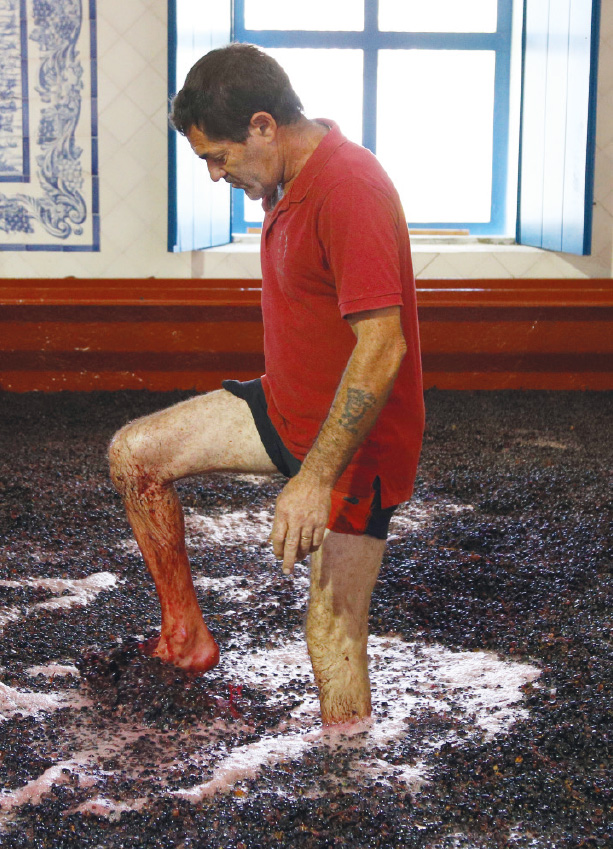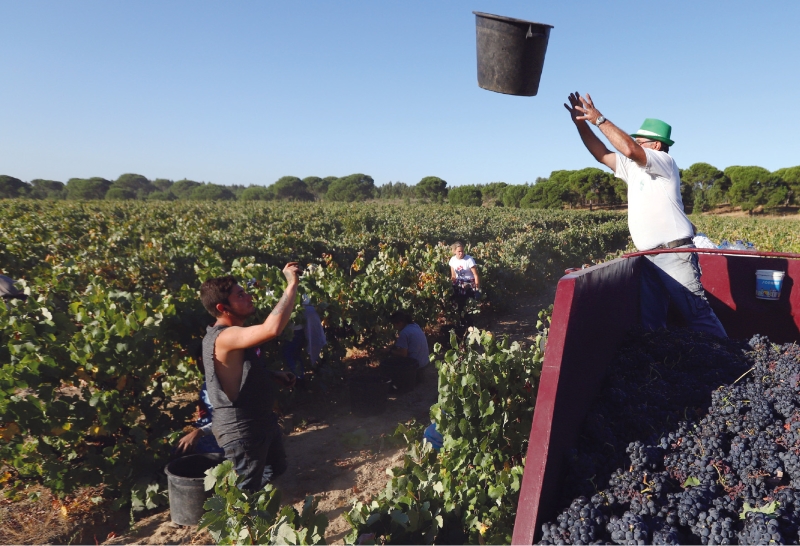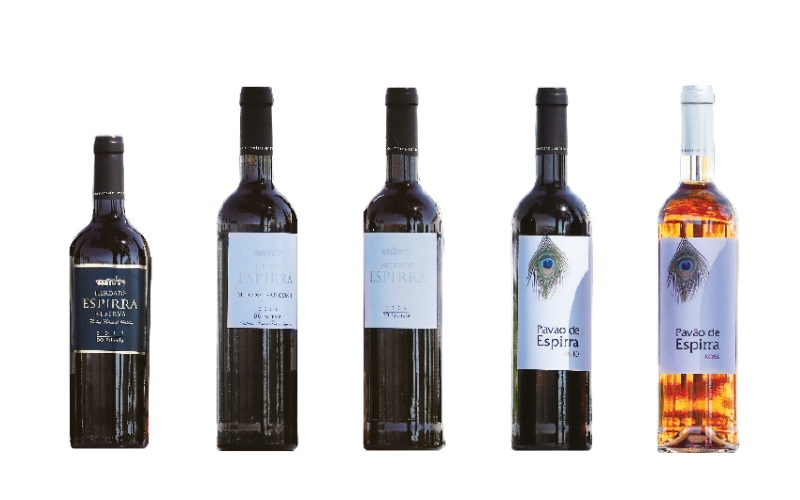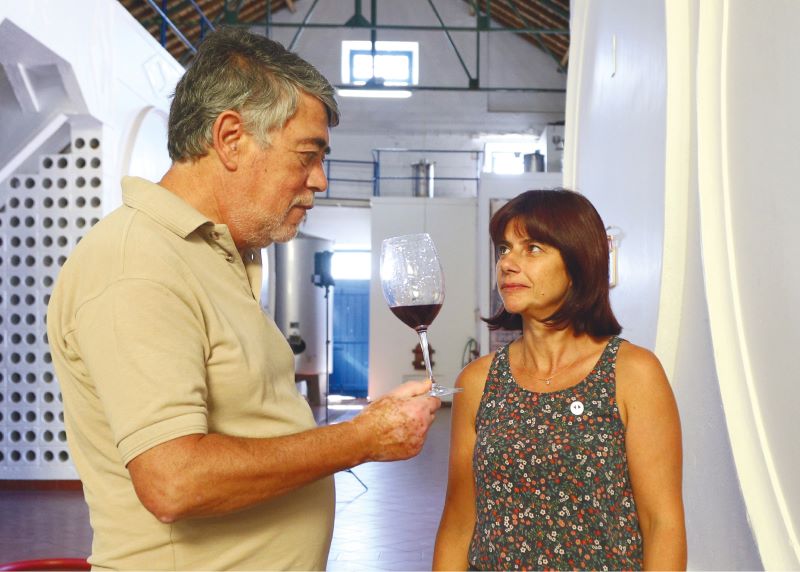It’s eight in the morning and the sun starts to warm the vineyards on the Espirra Estate, set on the Setúbal peninsula. There is row after row of lush vines as far as the eye can see, in vineyards stretching over 37 hectares. In the distance, we can see a tractor and the workers busy around it. As we get closer, the shapes and colours come into focus and we see several men and women, almost all of them wearing caps, leaning over to cut the bunches of grapes to fill up the huge buckets.
Maria Paula Bastos is 51 years old and has lost count of the number of grape harvests she’s worked on. The sweat drips from her face but she’s the liveliest in the group – she sings, tell jokes and encourages her workmates when the sun gets hot and harvesters grow weary. “All my life I’ve only worked in greenhouses and in the fields: some days go better than others, but it’s all part of the job,” she tells us, adding that “the important thing is to leave at the end of the day with a smile on your face.” For the second year running, Maria Paula has brought her daughter, a twenty-year-old also called Maria, to work on the grape harvest. “I like to be here because of the group spirit,” says the girl, as she expertly cuts the bunches off the vines.
Travelling up and down the rows of vines at the wheel of the tractor that carries the harvested grapes, Maria Helena, 52 years, is supervising the work. She’s the oldest worker in this group, and they all call here the “boss”. She’s being doing this seasonal work on the Espirra Estate for seventeen years, and she knows the vineyards better than anyone. When she’s not harvesting, she’s pruning or labelling the bottles in the cellar. She’s the first to arrive, and starts by organising large water bottles for the workers, taking them in to the vineyards. “It used to be that the people working on the harvest were older, they knew more about all this; but everything works out,” the chargehand told us, giving the others the signal to take a break.
It’s time for a short rest. A fifteen-minute break to grab a snack and drink water from the aluminium mugs that many have tied to their belts.
It’s the men’s job to carry the buckets of grapes and empty them into the tractor. Because these vines are more than thirty years old, the bunches of grapes reach almost down to the ground, and nothing is mechanised.
Luís Pereira, 55 years old, is a factory hand, but works here in his holidays to earn some extra cash from the harvest. Married to Maria Helena, he’s the one who takes the buckets of grapes and then, at midday, when the morning shift is over, drives the tractor over to the Setúbal Peninsul Regional Development Association (ADREPES), where the grapes are weighed. Today, in just a morning’s work, the group has picked three and a half tons of grapes. Luís repeats the journey in the evening, when the working day is over. The he drives the tractor to the receiving bin, where he unloads the grapes to be taken to the winepress where they are trodden.
Treading the grapes

When the vineyard workers break for lunch, Mário Azinha, aged 55 years, heads to the winepress to tread the grapes. At the Espirra Estate, the traditional method is still used for this. Harvesting manually means the grapes are carefully selected: only those in top condition and properly ripe are picked and sent to the winery.
Barefoot, in shorts and t-shirt, Mário steps into the press with around nine tons of grapes. The soup of red grapes is cool to his calloused feet . “When we get in, it’s cool, but then, when it ferments, it heats up,” explained Mário, who swapped his job as a car mechanic for a life in the country. Carefully, so as not to slip, he starts his “walk” around the four corners of the press, lifting his knees high to turn over the must. Under his feet, the fruit releases its juices.
The grapes stay in the press for around ten days to ferment, during which time they are trodden daily. Then, when the must is ready, in other words, when all the sugars have been transformed into alcohol, the liquid is removed to age in barrels of French oak. That’s how wine is born at the Espirra Estate.
A unique terroir, a traditional variety
The Espirra Estate extends over 1 700 hectares, much of which is woodlands – plantations of eucalyptus, cork oak and umbrella pines, pasture for sheep or goats, as well as nurseries and 37 hectares of vineyards. “Our vineyards show our concern with diversity and the company’s own sustainability,” explained Vasco Paiva, manager of the Espirra Winery. The estate is a patchwork of different crops and different types of woodland, as well as an established vineyard, planted more than thirty years ago, mostly with Castelão grapes, something of a rarity in the region. “The wine we produce is excellent and we’ve won a lot of prizes. It’s produced using traditional methods, hand picking and treading the grapes, which maintains a distinctive character unique in this terroir,” Vasco Paiva told us.
The main grape variety at the Espirra Estate is Castelão, accounting for around 32 of the total 37 hectares of vines. It’s a Portuguese variety, that thrives in sandy soils, like those of the Setúbal peninsula and neighbouring areas of the Alentejo. The five hectares of new vines divided into the Aragonês, Touriga Nacional and Alicante Bouchet varieties.
The difference between the old and new vines can be seen clearly in the yields. An old vine naturally produces much less grapes than a new vine. As a rule, Castelão vines in the prime, when ten or twelve years old, produce between 12 and 14 tons of grapes per hectare; because of their age, the Castelão vines on the Espirra Estate yield around five or six tons per hectare. The smaller yields result in more concentrated wines, in terms of their colour, aroma and even their structure.
Ana Varandas, oenologist at the Espirra Estate, says an oenologist’s job is to manage to produce the best grapes, keeping a watchful eye on their development, to ensure that external intervention is kept to a minimum and that the end result is outstanding. Despite the heat wave in the summer, she is confident that the 2018 vintage may be excellent. “My prediction is that the wine will be very good, quite possibly of reserve standard,” she confided.
The grape harvest is true to tradition: the fruit is picked by hand and then trodden in the presses

The Espirra Estate wines

Pavão de Espirra Rosé
The red Castelão grapes are harvested earlier, to obtain a lower alcohol content. After being picked by hand, they are macerated for two hours. They are then crushed and ferment without any contact with the skin, in stainless steel tanks, at a temperature controlled by a water shower to maintain fermentation at between 16 and 18 degrees.
Pavão de Espirra Red
The grape harvest starts with the vines where yields are highest, which will result in vine with a
lower alcohol content. Grapes are harvested by hand and then trodden in the traditional way in wine presses during the entire fermentation process. The wine is then transferred to tanks in the estate’s own winery. This is a fruity wine, with an aroma of berry fruits.
Herdade de Espirra Red
Some sections of the vineyard traditionally produce top-of-the-range wines. In these areas, the grapes are picked later, to ensure they are perfectly ripe. The grapes are harvested manually and then trodden in the traditional way and left in prolonged contact with the skins to extract all the aromas and the full complexity of the Castelão variety. The fermentation process is completed in the wine press, followed by ageing for 12 months in French oak barrels and a further 12 months in the bottle before being offered to consumers.
Herdade de Espirra Red Método Tradicional
The grapes are harvested manually and then trodden in the traditional way and left in prolonged contact with the skins to extract the full complexity of the Castelão grapes. The fermentation process is completed in the wine press and the wine is then bottled, without any contact with wood. This reflects the traditional method for Caastelão wines in the region, without using oak barrels.
Herdade de Espirra Reserva
This is the top-of-the-range wine, only produced in years when the harvest is exceptional. The grapes are harvested manually and then trodden in the traditional way and left in prolonged contact with the skins to extract the aromas and the complexity of the fruit. The fermentation process is completed in the presses in the estate’s own winery, and the wine is then aged for 24 months in French oak barrels and a further 12 months in the bottle.
“Our vineyards show our concerns for diversity and the company’s own sustainability” – Vasco Paiva
